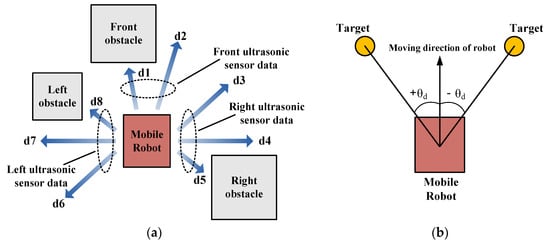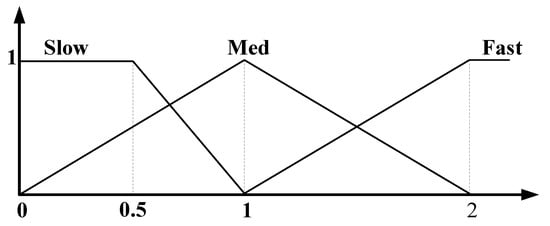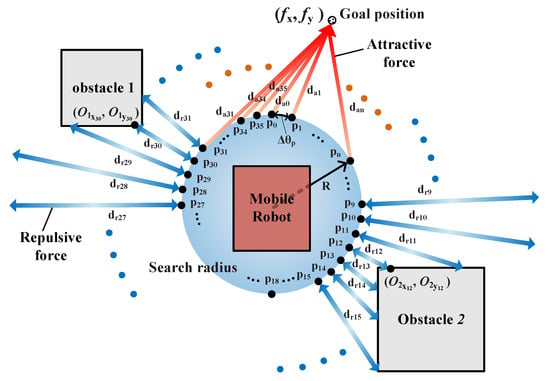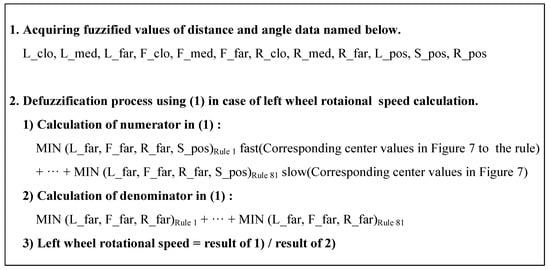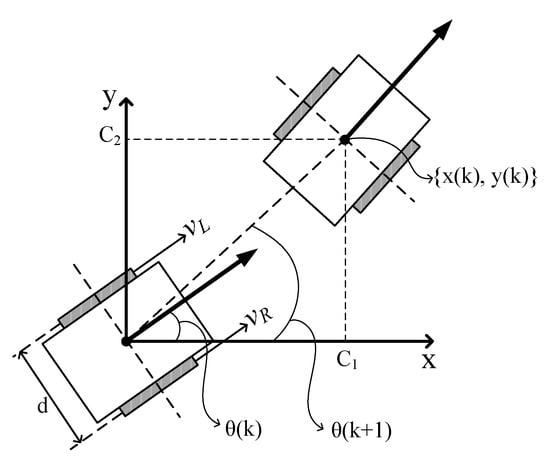Abstract
Topics concerning autonomous navigation, especially those related to positioning systems, have recently attracted increased research attention. The commonly available global positioning system (GPS) is unable to determine the positions of vehicles in GPS-shaded regions. To address this concern, this paper presents a fuzzy-logic system capable of determining the position of a moving robot in a GPS-shaded indoor environment by analyzing the chromaticity and frequency-component ratio of LED lights installed under the ceiling. The proposed system’s performance was analyzed by performing a MATLAB simulation of an indoor environment with obstacles. During the simulation, the mobile robot utilized a fuzzy autonomous navigation system with behavioral rules to approach targets successfully in a variety of indoor environments without colliding with obstacles. The robot utilized the x and y coordinates of the fuzzy positioning system. The results obtained in this study confirm the suitability of the proposed method for use in applications involving autonomous navigation of vehicles in areas with poor GPS-signal reception, such as in tunnels.
1. Introduction
Many studies have been conducted to develop autonomous navigation systems that can facilitate safe and efficient mobility of vehicles [,,,,]. Autonomous navigation systems combine new technologies, such as modern sensors, information communication, and intelligent control, to enable a vehicle to recognize its surrounding environment, analyze risks, and achieve active safety [,,,,]. Furthermore, the development of autonomous navigation technology could enhance the safety of driving via improvements in the range of recognition and reaction time, reduction in road accidents, alleviation of traffic congestion, and promotion of the automotive convergence industry [,,,,].
Behavior-based navigation algorithms are commonly used for developing autonomous navigation systems [,,,]. They determine the motion of a vehicle by using programmed behavior rules corresponding to the real-time information of the surroundings obtained from the mounted sensors. Moreover, these algorithms improve navigation skills, such as ensuring coping ability for unexpected situations while heading to a target and avoiding obstacles. However, to achieve more advanced navigation, multiple behavior rules generating a variety of vehicular motions corresponding to surrounding information must be included, and the problems involving combination between behavior rules should be considered [,,,].
Fuzzy-logic theory mimics human recognition ability, and it is widely employed in studies on autonomous navigation because it exhibits good performance in processing information gathered from the surrounding environment [,,,]. Fuzzy logic includes three stages: fuzzification, rule evaluation, and defuzzification. In the fuzzification process, all sensor data input to the fuzzy system have their own weights assigned by input membership functions. In the rule-evaluation process, the behavior rules are activated for sensor data with nonzero weights. In the defuzzification process, all the outputs from the behavior rules are combined using the defuzzification function. Because all the weights of the input signals are considered, and the behavior rules are well combined to produce an output—such as the motion of a robot. Fuzzy logic demonstrates excellent performance in systems addressing multiple environmental uncertainties, such as robot navigation algorithms [,,,].
Positioning is one of the most important techniques in autonomous navigation [,,,,]. A variety of positioning methods based on sensor techniques are currently utilized in the autonomous navigation systems of vehicles. Further, studies are underway to minimize the measurement errors that occur for each sensor and enhance the accuracy of the positioning results by utilizing the advantages of each positioning sensor [,,,,].
Commonly used positioning sensors present advantages as well as disadvantages. In the case of the global navigation satellite system (GNSS), the position of the receiver is calculated by using satellite networks through triangulation, utilizing the time at which the satellite signal arrives at the ground-surface receiver and the position information of other satellites. However, owing to various error factors, a positioning error of approximately 7 m occurs [,,,,,]. In addition, differential GNSS uses the ground master station to address satellite clock, ion/ionospheric, and orbit errors; the positioning error is approximately 2 m in this case, and obtaining an accurate measurement is still difficult [,]. Some studies have combined inertial navigation systems (INS), vision, radar, geomagnetic sensors, Wi-Fi, etc., to improve accuracy. However, Wi-Fi has a different positioning accuracy depending on the interval of installation and the number of surrounding signal sources (access points, APs). In INS-GPS, owing to the sensor bias and noise accumulation over time, the accuracy and reliability of positioning decrease [,,,,,]. In addition, GPS, which is widely used for vehicle positioning, measures a vehicle’s current position through a satellite using a function for transmitting navigation signals; consequently, it cannot measure the vehicle’s position in indoor and other GPS-shaded areas []. Therefore, INS-GPS cannot produce precise position measurements in areas where signal reception is difficult. Thus, while studies are continuously being conducted on sensor-measurement fusion technologies, many issues must still be addressed [,,,,,].
To improve positioning in GPS-shaded areas, many researchers have begun focusing on the visible light communication (VLC) technique using light emitting diode (LED) lighting [,,,,,]. VLC requires multiple LED networks, in which a unique ID is assigned to each LED transmitter, and positions are calculated via trilateration, whereby the distances from a receiver to the three closest transmitters are measured. Various measurement methods for LED-based VLC are available, including proximity [], finger printing [], received signal strength [], angle of arrival [], time of arrival, time difference of arrival, phase difference of arrival, and image-based positioning []. Although the proximity has a simple and inexpensive process, it yields low accuracy []. In contrast, the finger printing, received signal strength, arrival data (i.e., angle of arrival, time of arrival, time and phase difference of arrival), and image-based techniques are well-known for achieving high accuracy in LED-based indoor positioning. However, the equipment size and the complexity of hardware hinder their practical application [,].
In our previous study, a fuzzy-logic-based positioning system was developed using the chromaticity and frequency components of LED light [], and it could successfully detect the position of a mobile robot in the developed simulator.
In this present study, the fuzzy positioning system was implemented for two autonomous mobile robot navigation systems, and the performance of the fuzzy positioning system in each navigation system were compared. The first navigation system comprises fuzzy-logic–based behavior rules that determine the motion of the mobile robot while it moves toward a target and avoids obstacles simultaneously. The second navigation system is based on the potential field method wherein the robot finds a path such that the attractive force from the target is maximized and the repulsive forces from obstacles are minimized [,]. The mobile robot operating based on the two proposed navigation algorithms utilizes the chromaticity and frequency component ratio of LED light obtained via the optimal route to avoid and escape obstacles and reach targets without having any pre-installed localized information.
2. Positioning Method
2.1. Experimental Environment
In this study, we developed a simulator that imitates GPS-shaded areas, as depicted in Figure 1. The color temperatures of LED illuminators depicted in Figure 1 equaled 3000, 4500, and 6000 K, and the said illuminators were installed 73 cm above the simulator floor. Each LED-lighting fixture measured 1 m long—a combination of two 50 cm long bar lamps. Individual fixtures were placed 20 cm apart. The simulator floor was marked by a grid comprising square elements measuring 5 cm each along the x- and y- directions, as depicted in Figure 1. On the grid, the red dots indicate points of intersections between the horizontal and vertical grid lines, and they represent chromaticity measurement points. Therefore, in this study, reference-data measurements were performed at 21 points.
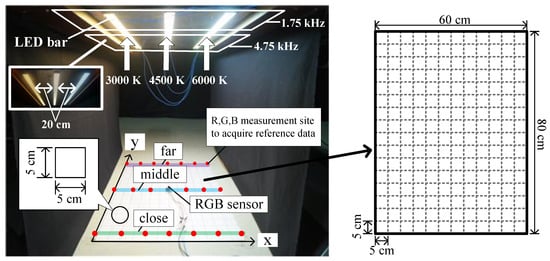
Figure 1.
Indoor-environment simulator used in this study and size of testbed [].
It is noteworthy that the front and rear bar lamps comprising the LED illuminator operated at different frequencies, thereby separating the illumination zones along the y-axis. Figure 1 shows the irradiation of 1.75 kHz light on the elliptical part of the LED illuminators and that of 4.75 kHz light on the rectangular part.
By configuring the simulator in this manner, the positioning in the x-axis direction is calculated based on the chromaticity value, whereas that in the y-axis direction is calculated based on the different frequency-component ratios of the LED-irradiated light.
Figure 2 shows the signal-processing procedure used in this study []. An RGB sensor (HDJD-s822) is used for performing positioning on the mesh grid on the simulator floor. The RGB sensor detects the light irradiated by the three LED fixtures located on the ceiling of the simulator and outputs R, G, and B voltage signals. The LED illuminators irradiate 1.75 and 4.75 kHz light for each section, as shown in Figure 1. For this purpose, the LED illuminators are controlled using a power switching method that employs pulse width modulation.
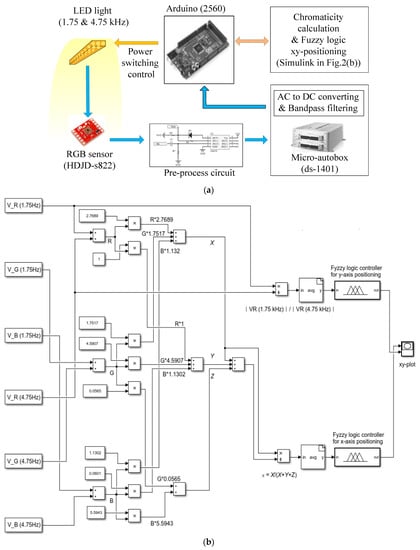
Figure 2.
Signal-processing workflow: (a) Schematic of signal-processing procedure; (b) Simulink model for fuzzy positioning.
To block the effects of other external lights and to select only the driving frequency components of the LED illuminators, the preprocessed signals were passed through a bandpass filter that allowed only the 1.75-kHz and 4.75-kHz signals to pass. The Direct-Form-II infinite-impulse-response bandpass filter was designed using MATLAB FDA Toolbox and implemented using MATLAB Simulink. The Simulink model of the bandpass filter works with the Micro-Autobox (ds-1401) DAQ to conduct signal filtering. The DAQ output signals were converted into DC via a smoothing circuit comprising a capacitor, following which the chromaticity value and frequency-component ratio were calculated using Arduino 2506. Finally, the x- and y-axis coordinates were estimated using the corresponding fuzzy systems. Processing in the Arduino board was implemented as a MATLAB Simulink model linked to the board via the MATLAB Embedded Coder Toolbox.
2.2. Fuzzy Positioning System
In the constructed simulator, three LEDs with different colored temperatures in the x-axis direction were installed on the ceiling. The overlapping of light was considered, following which different chromaticity values were measured depending on the position of the RGB sensor in the x-axis direction.
We first collected reference chromaticity data corresponding to the positional coordinates in the x-axis direction. The red dot on the mesh grid in Figure 1 denotes the location of the collected reference data. Thus, for obtaining reliable measurements of the x-axis in the interior of the simulator, the x coordinate was increased from zero to 60 cm in increments of 10 cm, and the chromaticity data were collected at each point on the lines indicated by “close”, “med” and “far” intersecting each x-axis coordinate. Figure 3a shows the variation in the mean values of chromaticity data along the x-axis.
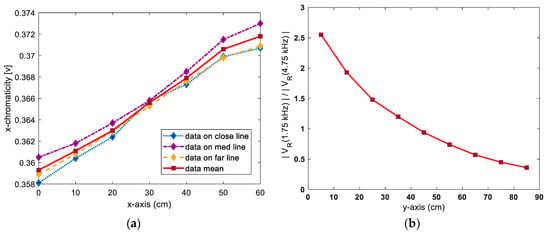
Figure 3.
Reference-data variations along x- and y- axes: (a) Chromaticity variation along x-axis; (b) frequency-component-ratio variation along y-axis.
As shown in Figure 1, the bar-shaped LED illuminators installed on the ceiling of the tunnel simulator were driven by power-switching methods at 1.75 and 4.75 kHz for each section. In this study, the y-axis position coordinate was calculated using the 1.75 kHz frequency-component ratios included in the sensor output signal, corresponding to the position change along the y-axis.
For collection of the reference data, the RGB sensor was fixed at 30 cm on the x-axis. As the sensor was moved along the y-axis from 5 to 85 cm in increments of 10 cm, the magnitudes of the 1.75 and 4.75 kHz signals, subject to the bandpass filter and smoothing circuit, were measured. These measurement values were obtained to calculate the frequency-component ratios (|VR(1.75 kHz)|/|VR(4.75 kHz)|). Figure 3b shows the frequency-component ratios corresponding to the y-axis coordinates at which the sensor was located. Based on the reference data shown in Figure 3, a fuzzy positioning system was developed []. In this study, a fuzzy-logic positioning system was designed with MATLAB to calculate the x and y-coordinates corresponding to the position of a mobile robot from data pertaining to the chromaticity and the frequency-component ratio of the light. Data points corresponding to x-chromaticity and the frequency-component ratio (i.e., points other than those shown in Figure 3) were estimated by using linear approximation between the two-boundary data, which involved every two-neighbored reference data point in Figure 3. In this way, all the data points corresponding to the x-chromaticity and frequency-component ratio at the location of the mobile robot in the MATLAB-based simulation were estimated; these were then utilized as inputs to the fuzzy positioning system which calculates the 2-D Cartesian coordinates. Figure 4 summarizes the fuzzy positioning process [].

Figure 4.
Schematic of fuzzy positioning system [].
6. Results
In this study, the performances of two navigation systems (fuzzy logic and potential field navigation systems, both utilizing the fuzzy positioning system) were evaluated with the developed robot navigation simulator. Figure 13a–d show the simulation results, paths of the robot, and avoidance of obstacles until the robot reaches the targets in various environments. In the results, the robot in each moving step is symbolized by square shapes, wherein the blue and red colors represent the moving path of the robot using fuzzy logic and potential field navigation, respectively. In the moving path, the denser parts of overlapped square shapes indicate that the moving velocity is lesser than that of the other parts.
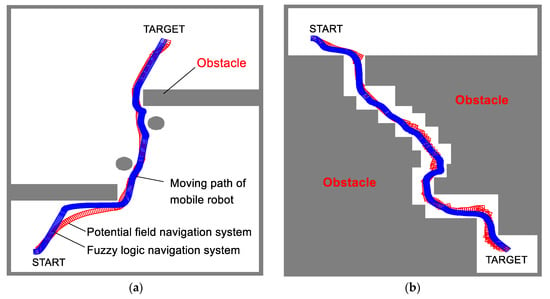
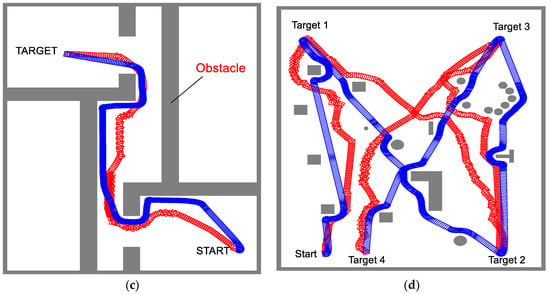
Figure 13.
Simulation results of autonomous fuzzy navigation system with fuzzy positioning—(□: navigation path using fuzzy logic navigation system, □: navigation path using potential field navigation system): (a) navigation path to reach target after avoiding obstacles; (b) navigation path in narrow pathway; (c) navigation path to reach to the target in a room; (d) navigation path to reach multiple targets.
Figure 13a shows the robot’s path to the target after it avoided round and square-shaped obstacles; the navigation is shown to be successful without any collisions occurring with the obstacles. As shown in Figure 13b, the robot navigated through a passageway to reach the target, and Figure 13c shows the path from one room to another. Figure 13d shows the performance of the navigation system in an environment with scattered obstacles. The robot reached the final target after three other targets without any collisions.
Table 4 summarizes the simulation results of the study in terms of path length, navigation time, and robot velocity. For the fuzzy navigation system, the velocity of the robot varies depending on the value of the coupling constant K in Equations (6) and (7). In this study, the value of K was set such that it minimized the errors between the simulation results and the performance of the actual robot, the latter being subject to a function of hardware specifications. Ultimately, the values of K and r were set to 1 rad/s and 3 cm, respectively. For the potential field navigation system wherein the linear approximation method was used to calculate moving distance in each step, the linear function was set such that it produced distance values in the range from 3–4 cm corresponding to the minimum distance value in the simulation environment, and these results indicate that the potential field navigation system shows a higher moving velocity than the fuzzy logic navigation system.

Table 4.
Rules for avoiding obstacles in robot navigation.
For an obstacle, the behavioral rules for following the edge of the obstacles in the fuzzy logic navigation system were activated in the fuzzy rule evaluation stage; the robot with fuzzy logic navigation follows the edge of obstacles, which results in a higher path length (Figure 13a), whereas the robot with potential field navigation moves toward the middle of the pathway because the repulsive potential is minimized here, resulting in a shorter path length (Figure 13b–d). Thus, the moving paths of the two navigation techniques are different.
Among all results, the fuzzy logic navigation system showed a smoother moving path than the potential field navigation system, as shown in Figure 12. The 81 behavior rules as well as the 4 input and 2 output membership functions in the fuzzy logic navigation system interact well; further, the fuzzy logic navigation system produced smoother moving paths than the potential field navigation system, wherein the steering angle is calculated according to the repulsive and attractive potential data.
A faster navigation velocity was observed in simulation 4 than in other simulations while simulation 4 also exhibited longer navigation time and distance. We think that the navigation velocity was affected by the density of surrounding obstacles, resulting in a faster moving velocity in the environment with scattered obstacles (simulation 4) compared with the other environments.
According to the results, the fuzzy positioning process in [] demonstrated good performance because the chromaticity and frequency component data utilized during the simulation were gathered within the simulator environment (Figure 1) via the bandpass filtering, without the interference of other lights. However, for real-time applications of the proposed technique, an improved filter technique is required, along with an investigation of various chromaticity and frequency component applications of LED light, to minimize the influence of other lights that cause positioning errors.
7. Conclusions
In this study, an autonomous robot navigation system was developed for indoor environments using the fuzzy logic navigation system and potential field navigation system, and both systems utilized the fuzzy positioning system. The positioning system utilized chromaticity and frequency component ratio data, which were obtained from the LED lighting that was installed under the ceiling in the simulation environment.
To evaluate the performance of the autonomous navigation system, various simulations that mimicked indoor environments were conducted. The navigation simulator generated the path of a mobile robot using the proposed systems until the robot reached the target. When the robot navigated by the fuzzy logic navigation system through the unknown environment, it used eight virtual distance sensors, and the steering angle and moving distance were calculated using 81 behavior rules and fuzzy membership functions. When the robot navigated by the potential field navigation system, the repulsive and attractive forces on 36 points of the searching radius, which is a circle surrounding the mobile robot, were used to calculate steering angle. This also led the robot to the position of minimum potential. The moving distance in the potential field navigation system was calculated with a linear function that produces the moving distance corresponding to the minimum distance data to surrounding obstacles in the following step.
The x and y coordinates of both navigation systems were calculated using the fuzzy positioning system based on pre-measured chromaticity and frequency component ratio data. The robot successfully reached the targets in various simulation environments using both navigation systems.
In this study, the possibility of implementing LED lighting–based indoor navigation systems was evaluated. In the future, a practical test will be performed using practical robots.
Author Contributions
Conceptualization and methodology, J.-H.J.; K.P.; software, K.P.; validation, J.-H.J., K.P.; investigation, J.-H.J.; K.P.; resources, J.-H.J.; K.P.; data curation, J.-H.J.; K.P.; writing–original draft preparation, J.-H.J.; writing–review and editing, K.P.; visualization, J.-H.J.; K.P.; supervision, K.P.; project administration, K.P. All authors have read and agreed to the published version of the manuscript.
Funding
This research was supported by the Youngsan University Research Fund of 2020.
Institutional Review Board Statement
Not applicable.
Informed Consent Statement
Not applicable.
Acknowledgments
The authors gratefully acknowledge the helpful comments and suggestions of the reviewers, which have greatly improved the quality of the paper.
Conflicts of Interest
The authors declare no conflict of interest.
References
- Jeong, J.H.; Lee, D.H.; Byun, G.S.; Cho, H.R.; Cho, Y.H. The tunnel lane positioning system of an autonomous vehicle in the LED lighting. J. Korean Inst. Intell. Transp. Syst. 2017, 16, 186–195. [Google Scholar] [CrossRef]
- Jeong, J.H.; Kim, M.; Byun, G.S. Position recognition for an autonomous vehicle based on vehicle-to-led infrastructure. AETA 2016 Recent Adv. Electr. Eng. Relat. Sci. Lect. Notes Electr. Eng. 2017, 415, 913–921. [Google Scholar]
- Kong, S.H.; Jeong, G.S. GPS/GNSS based vehicular positioning and navigation techniques. Int. J. Automot. Technol. 2015, 37, 24–28. [Google Scholar]
- Kong, S.H.; Jeon, S.Y.; Ko, H.W. Status and trends in the sensor fusion positioning technology. J. Korean Inst. Commun. Inf. Sci. 2015, 32, 45–53. [Google Scholar]
- Lee, J.K. Automatic driving cars developments trends and implications. Inst. Korean Electr. Electron. Eng. 2015, 64, 24–28. [Google Scholar]
- Kabanza, F.; Lamine, K.B. Specifying failure and progress conditions in a behavior-based robot programming system. In Proceedings of the 4th International Cognitive Robotics Workshop, Valencia, Spain, 23−24 August 2004; pp. 11–16. [Google Scholar]
- Li, W. Fuzzy Logic-Based ‘Perception-action’ behavior control of mobile robot in uncertain environments. Proc. IEEE Int. Conf. Fuzzy Syst. 1994, 3, 1626–1631. [Google Scholar]
- Zhang, N.; Beetner, D.; Wunsch, D.C., II; Hemmelman, B.; Hasan, A. An embedded real-time neuro-fuzzy controller for mobile robot navigation. In Proceedings of the 14th IEEE International Conference on Fuzzy Systems, 2005. FUZZ ‘05, Reno, NV, USA, 25 May 2005; pp. 319–323. [Google Scholar]
- Pandey, A.; Pandey, S.; DR, P. Mobile robot navigation and obstacle avoidance technique: A review. Int. J. Robot. Autom. 2017, 2, 96–105. [Google Scholar] [CrossRef] [Green Version]
- Yun, D.S.; Yu, H.S. Development of the optimized autonomous navigation algorithm for the unmanned vehicle using extended Kalman filter. Korean Soc. Automot. Eng. 2008, 16, 7–14. [Google Scholar]
- Chung, B.M.; Seok, J.W.; Cho, C.S.; Lee, J.W. Autonomous tracking control of intelligent vehicle using GPS information. J. Korean Soc. Precis. Eng. 2008, 25, 58–66. [Google Scholar]
- Zhu, H.; Yuen, K.-V.; Mihaylova, L.; Leung, H. Overview of environment perception for intelligent vehicles. IEEE Trans. Intell. Transp. Syst. 2017, 18, 2584–2601. [Google Scholar] [CrossRef] [Green Version]
- Wang, J.; Schroedl, S.; Mezger, K.; Ortloff, R.; Joos, A.; Passegger, T. Lane keeping based on location technology. IEEE Trans. Intell. Transp. Syst. 2005, 6, 351–356. [Google Scholar] [CrossRef]
- Ma, B.; Lakshmanan, S.; Hero, A.O. Simultaneous detection of lane and pavement boundaries using model-based multisensor fusion. IEEE Trans. Intell. Transp. Syst. 2000, 1, 135–147. [Google Scholar] [CrossRef]
- Topfer, D.; Spehr, J.; Effertz, J.; Stiller, C. Efficient road scene understanding for intelligent vehicles using compositional hierarchical models. IEEE Trans. Intell. Transp. Syst. 2015, 16, 441–451. [Google Scholar] [CrossRef]
- Nakajima, M.; Haruyama, S. New indoor navigation system for visually impaired people using visible light communication. EURASIP J. Wirel. Commun. Netw. 2013, 2013, 37–46. [Google Scholar] [CrossRef] [Green Version]
- Vongkulbhisal, J.; Chantaramolee, B.; Zhao, Y.; Mohammed, W.S. A fingerprinting-based indoor localization system using intensity modulation of light emitting diodes. Microw. Opt. Technol. Lett. 2012, 54, 1218–1227. [Google Scholar] [CrossRef]
- Kim, H.S.; Kim, D.R.; Yang, S.H.; Son, Y.H.; Han, S.K. An indoor visible light communication positioning system using a RF carrier allocation technique. J. Lightwave Technol. 2012, 31, 134–144. [Google Scholar] [CrossRef]
- Cossu, G.; Presi, M.; Corsini, R.; Choudhury, P.; Khalid, A.M.; Ciaramella, E. A visible light localization aided optical wireless system. In Proceedings of the IEEE GLOBECOM Workshops, Houston, TX, USA, 5–9 December 2011; pp. 802–807. [Google Scholar]
- Zhuang, Y.; Hua, L.; Qi, L.; Yang, J.; Cao, P.; Cao, Y.; Wu, Y.; Thompson, J.; Haas, H. A survey of positioning systems using visible LED lights. IEEE Commun. Surv. Tutor. 2018, 20, 1963–1988. [Google Scholar] [CrossRef] [Green Version]
- del Campo-Jimenez, G.; Perandones, J.M.; Lopez-Hernandez, F.J. A VLC-based beacon location system for mobile applications. In Proceedings of the IEEE International Conference on Localization and GNSS (ICL-GNSS), Turin, Italy, 25–27 June 2013; pp. 1–4. [Google Scholar]
- Fang, J.; Yang, Z.; Long, S.; Wu, Z.; Zhao, X.; Liang, F.; Jiang, Z.L.; Chen, Z. High-speed indoor navigation system based on visible light and mobile phone. IEEE Photonics J. 2017, 9, 1–11. [Google Scholar] [CrossRef]
- Rahman, M.S.; Haque, M.M.; Kim, K.-D. Indoor positioning by LED visible light communication and image sensors. Int. J. Electr. Comput. Eng. 2011, 1, 161–170. [Google Scholar] [CrossRef]
- Jeong, J.H.; Byun, G.S.; Park, K. Fuzzy logic vehicle positioning system based on chromaticity and frequency components of LED illumination. IEEE Photonics J. 2019, 11, 1–12. [Google Scholar] [CrossRef]
- Ünal, A.S.İ.L.; Erkan, U.S.L.U. Potential field path planning and potential field path tracking. In Proceedings of the Innovations in Intelligent Systems and Applications Conference (ASYU), Istanbul, Turkey, 15–17 October 2020; pp. 1–4. [Google Scholar]
- Lin, X.; Wang, Z.-Q.; Chen, X.-Y. Path planning with improved artificial potential field method based on decision tree. In Proceedings of the 27th Saint Petersburg International Conference on Integrated Navigation Systems (ICINS), Saint Petersburg, Russia, 25–27 May 2020; pp. 1–5. [Google Scholar]
Publisher’s Note: MDPI stays neutral with regard to jurisdictional claims in published maps and institutional affiliations. |
© 2021 by the authors. Licensee MDPI, Basel, Switzerland. This article is an open access article distributed under the terms and conditions of the Creative Commons Attribution (CC BY) license (https://creativecommons.org/licenses/by/4.0/).
